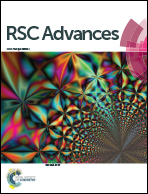Stabilization of ruthenium on biochar-nickel magnetic nanoparticles as a heterogeneous, practical, selective, and reusable nanocatalyst for the Suzuki C–C coupling reaction in water†
Abstract
Waste recycling and the use of recyclable and available catalysts are important principles in green chemistry in science and industrial research. Therefore in this study, biochar nanoparticles were prepared from biomass pyrolysis. Then, they were magnetized with nickel nanoparticles to improve their recycling. Further, the magnetic biochar nanoparticles (biochar-Ni MNPs) were modified by dithizone ligand and then applied for the fabrication of a ruthenium catalyst (Ru-dithizone@biochar-Ni MNPs). This nanocatalyst was characterized by high-resolution transmission electron microscopy (HRTEM), scanning electron microscopy (SEM), energy-dispersive X-ray spectroscopy (EDS), wavelength dispersive X-ray spectroscopy (WDX), N2 adsorption–desorption isotherms, thermogravimetric analysis (TGA), X-ray diffraction (XRD), and vibrating sample magnetometry (VSM) techniques. The XRD studies of Ru in the nanocatalyst showed that the crystalline structure of ruthenium in the Ru-dithizone@biochar-Ni MNPs was hcp. Another principle of green chemistry is the use of safe and inexpensive solvents, the most suitable of which is water. Therefore, the catalytic activity of this catalyst was investigated as a practical, selective, and recyclable nanocatalyst in the Suzuki carbon–carbon coupling reaction in aqueous media. The VSM curve of this catalyst showed that it could be easily recovered using an external magnet, and recycled multiple times. Also, VSM analysis of the recovered catalyst indicated the good magnetic stability of this catalyst after repeated use.



 Please wait while we load your content...
Please wait while we load your content...